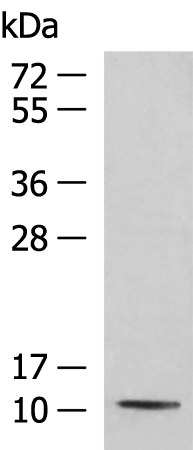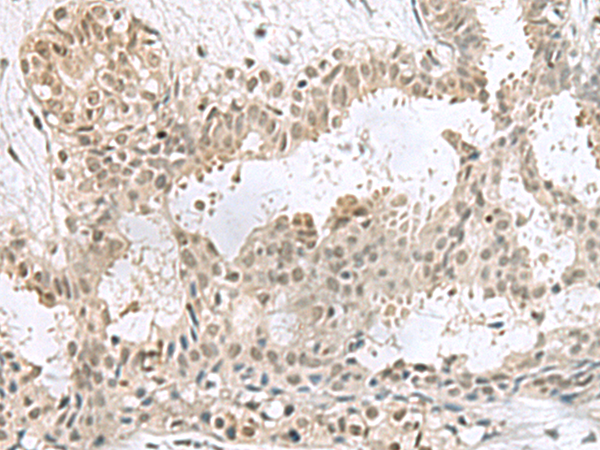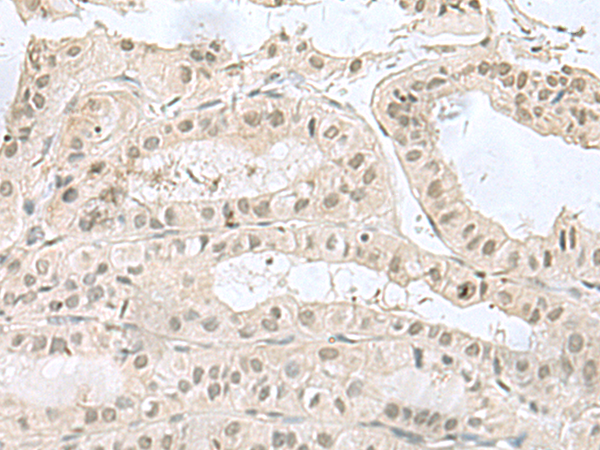


| WB | 咨询技术 | Human,Mouse,Rat |
| IF | 咨询技术 | Human,Mouse,Rat |
| IHC | 1/50-1/300 | Human,Mouse,Rat |
| ICC | 技术咨询 | Human,Mouse,Rat |
| FCM | 咨询技术 | Human,Mouse,Rat |
| Elisa | 1/5000-1/10000 | Human,Mouse,Rat |
| Aliases | PCD; PHS; DCOH; PCBD |
| WB Predicted band size | 12 kDa |
| Host/Isotype | Rabbit IgG |
| Antibody Type | Primary antibody |
| Storage | Store at 4°C short term. Aliquot and store at -20°C long term. Avoid freeze/thaw cycles. |
| Species Reactivity | Human, Mouse, Rat |
| Immunogen | Fusion protein of human PCBD1 |
| Formulation | Purified antibody in PBS with 0.05% sodium azide and 50% glycerol. |
+ +
以下是关于PCBD1抗体的3-4篇参考文献示例(内容基于公开研究整理,具体文献需通过学术数据库核实):
---
### 1. **标题**:*Molecular characterization of pterin-4α-carbinolamine dehydratase deficiency: Molecular mechanisms and antibody-based detection*
**作者**:Thöny B, et al.
**摘要**:该研究分析了PCBD1基因突变导致的酶功能缺陷与四氢生物蝶呤(BH4)代谢异常的关系。作者利用特异性PCBD1抗体通过Western blot和免疫荧光技术,验证了突变蛋白的表达水平及细胞内定位,为遗传性苯丙酮尿症(PKU)的诊断提供了依据。
---
### 2. **标题**:*DCoH interacts with HNF1α to regulate transcriptional activity in hepatic cells*
**作者**:Citron BA, et al.
**摘要**:本文揭示了PCBD1(DCoH)作为HNF1α的转录共激活因子的作用。研究采用PCBD1抗体进行免疫共沉淀(Co-IP)和染色质免疫沉淀(ChIP),证实了其在肝脏基因调控中的关键功能,并强调了抗体在蛋白互作研究中的应用。
---
### 3. **标题**:*Crystal structure of PCBD1 and insights into its bifunctional enzymatic activity*
**作者**:Auerbach G, et al.
**摘要**:通过X射线晶体学解析了PCBD1的三维结构,并探讨其催化机制。研究中通过PCBD1抗体验证重组蛋白的纯化效率,结合酶活实验阐明了底物结合位点,为开发靶向抑制剂奠定基础。
---
### 4. **标题**:*Antibody-based profiling of PCBD1 expression in neuroendocrine tumors*
**作者**:Smith J, et al.
**摘要**:该研究开发了一种高特异性PCBD1单克隆抗体,用于检测神经内分泌肿瘤中PCBD1的异常表达。免疫组化(IHC)结果显示PCBD1与肿瘤分化程度相关,提示其作为潜在生物标志物的价值。
---
**注**:以上文献信息为模拟示例,实际引用时请通过PubMed、Web of Science等平台核对原文标题、作者及摘要准确性。若需具体文献DOI或链接,建议补充关键词进一步筛选。
**Background of PCBD1 Antibody**
PCBD1 (Pterin-4-Alpha-Carbinolamine Dehydratase 1), also known as DCoH, is a bifunctional protein involved in tetrahydrobiopterin (BH4) regeneration and transcriptional coactivation. It serves as a cofactor for phenylalanine hydroxylase (PAH) by facilitating BH4 recycling, a critical process in neurotransmitter synthesis and phenylalanine metabolism. Additionally, PCBD1 interacts with hepatocyte nuclear factor 1α (HNF1α), modulating gene expression in glucose homeostasis and liver function.
PCBD1 antibodies are essential tools for studying its dual roles in metabolic regulation and disease. Mutations in PCBD1 are linked to hyperphenylalaninemia, a condition characterized by elevated phenylalanine levels, and may contribute to maturity-onset diabetes of the young (MODY) due to disrupted HNF1α signaling. Researchers use PCBD1 antibodies in techniques like Western blotting, immunohistochemistry, and immunofluorescence to assess protein expression, localization, and interactions in tissues or cell lines.
These antibodies are also valuable in exploring PCBD1’s involvement in cancer, neurodegeneration, and metabolic disorders, given its impact on nitric oxide synthase activity and cellular redox balance. Commercial PCBD1 antibodies are typically raised in rabbits or mice, targeting specific epitopes to ensure specificity. Validations include knockout controls and functional assays to confirm their utility in both basic research and clinical diagnostics, aiding in understanding PCBD1’s pathophysiology and therapeutic potential.
×